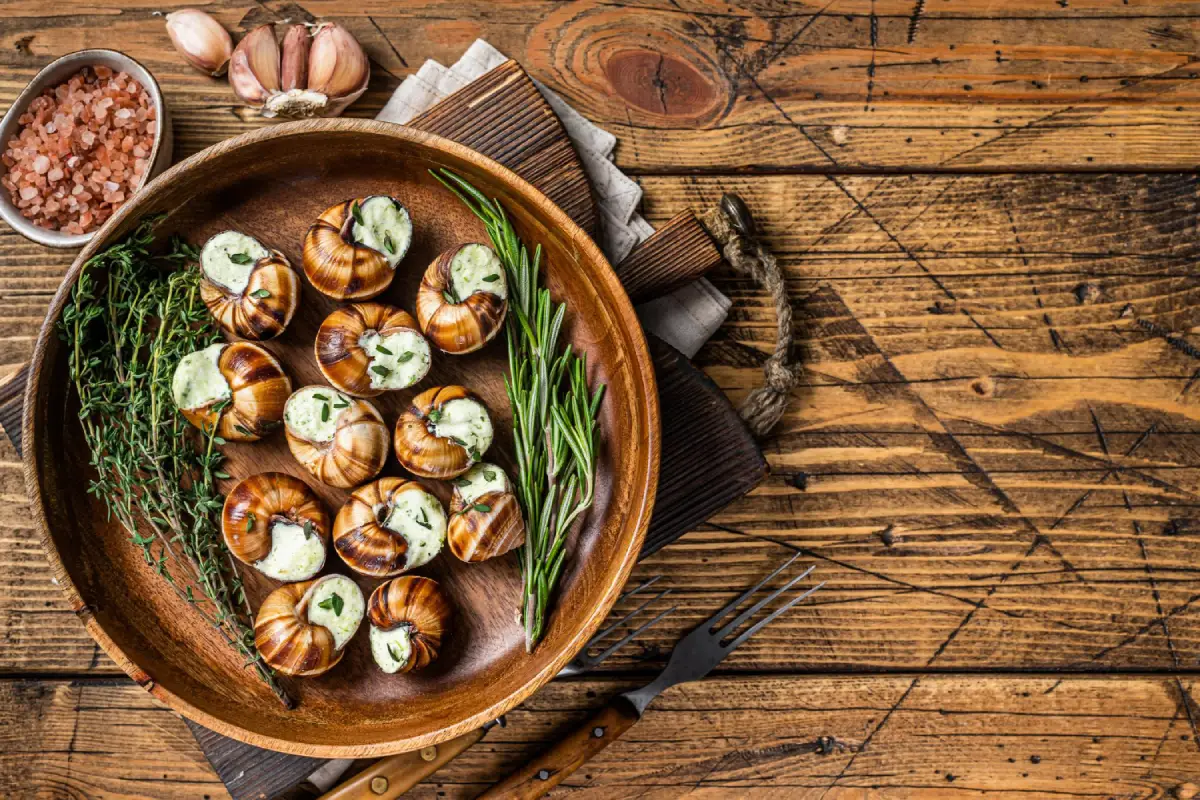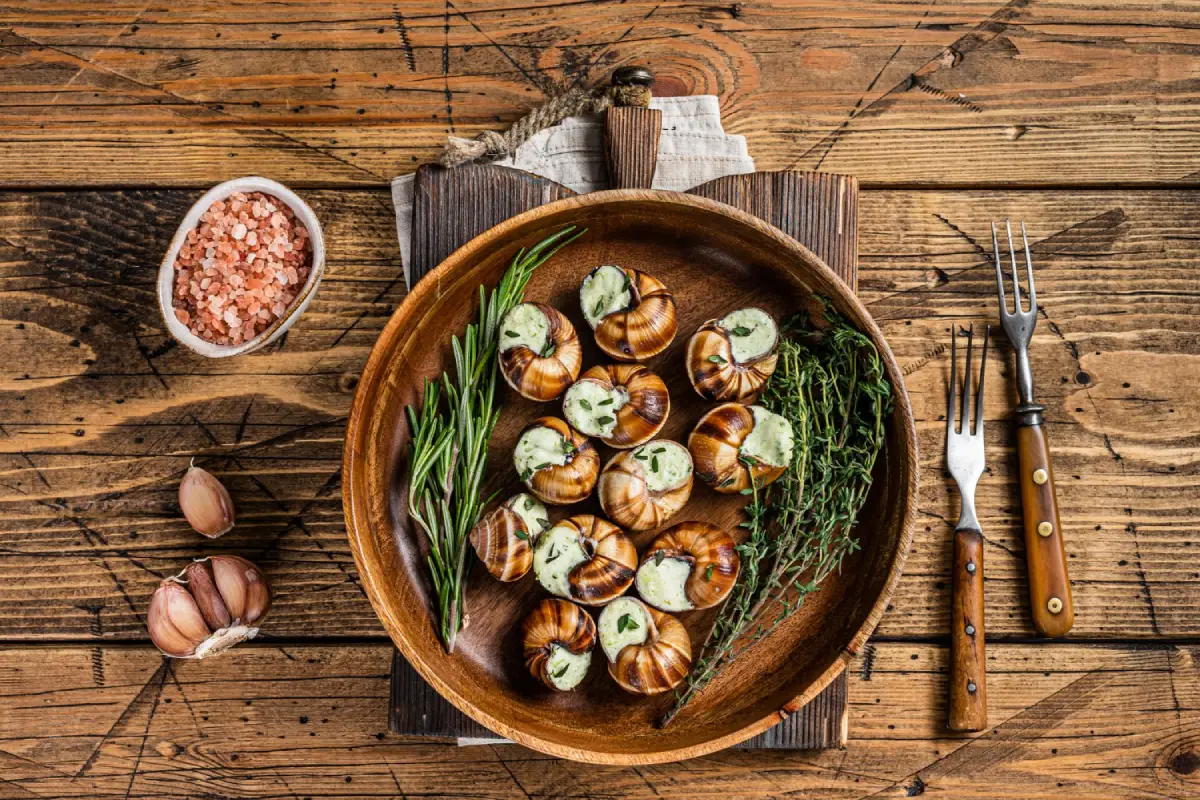Mastering Garlic Butter
The soul of French Escargot lies in its garlic butter, a simple yet profound blend that elevates the dish. Crafting the perfect garlic butter involves balancing quality butter with fresh garlic, parsley, and a hint of salt. Here’s how to make it:
- Ingredients:
- 1 cup (2 sticks) unsalted butter, softened
- 2 tablespoons fresh parsley, finely chopped
- 4 garlic cloves, minced
- 1/2 teaspoon salt
- A pinch of black pepper (optional)
- Preparation:
- In a mixing bowl, combine the softened butter with minced garlic, chopped parsley, salt, and pepper until well blended.
- Mix thoroughly until the ingredients are evenly distributed throughout the butter.
This garlic butter can be prepared ahead of time and stored in the refrigerator. Let it soften before applying to your escargot, ensuring it melts beautifully into the snails and infuses them with flavor. With this garlic butter, you’ll bring out the true essence of French Escargot, creating a memorable dish that’s rich, flavorful, and deeply satisfying.

Preparing and Cooking Escargot
The preparation and cooking of escargot might seem daunting, but with the right approach, it can be a straightforward and rewarding process. Here’s how to prepare and cook your escargot to perfection:
- Cleaning and Preparing Fresh Snails (if applicable):
- If using fresh snails, ensure they have been purged, cleaned, and cooked. Boil the snails in water for about 3 minutes, then rinse and remove them from their shells with a small fork.
- Prepping Snails for Baking:
- Whether you’re using fresh or canned snails, pat them dry with paper towels. Place a small amount of garlic butter in each escargot shell or baking dish, add the snail, then top with additional garlic butter.
- Baking:
- Preheat your oven to 400°F (200°C). Arrange the snails on a baking sheet or in a specialized escargot dish. Bake for 10-12 minutes, or until the butter is sizzling and slightly golden.
- Serving:
- Serve hot, accompanied by crusty bread to soak up the delicious garlic butter.
By following these steps, you’ll ensure your escargot is tender, flavorful, and beautifully presented. Cooking escargot at home brings a touch of French elegance to your table, offering a dish that’s as delightful to prepare as it is to savor.
Serving and Presentation Tips
Presenting your escargot with style is just as important as the cooking process itself. Here are some tips to elevate your dish’s presentation:
- Use Traditional Escargot Dishes: If available, serve your escargot in traditional ceramic or metal dishes designed for this purpose. These dishes have individual wells for each snail, making for an elegant presentation.
- Garnish Wisely: A sprinkle of finely chopped parsley over the finished escargot adds a fresh pop of color and enhances the flavor. A lemon wedge on the side can also offer a bright contrast to the rich butter.
- Bread on the Side: Always offer crusty, fresh bread alongside escargot. It’s perfect for dipping into the sumptuous garlic butter and ensures none of it goes to waste.
- Plating with Precision: For a modern twist, consider plating escargot on a bed of coarse sea salt or atop a small salad. This approach can add texture and visual appeal to your dish.
By incorporating these serving and presentation tips, you’ll not only impress your guests with the flavors of your escargot but also with the care and attention to detail in its presentation. Remember, eating with the eyes makes each bite taste even better.
Wine Pairings
Selecting the right wine to accompany your French Escargot Snails with Garlic Butter can elevate the meal, creating a harmonious dining experience. Here are some wine pairing suggestions to complement the rich flavors of the dish:
- Chardonnay: A buttery, oak-aged Chardonnay can mirror the richness of the garlic butter while balancing the dish’s savory notes. Look for a bottle with a hint of minerality to cut through the richness.
- Sauvignon Blanc: For a fresher pairing, a crisp Sauvignon Blanc with its zesty acidity can lighten the dish’s heaviness, enhancing the herbal qualities of the parsley and the freshness of the snails.
- Pinot Gris: Offering a middle ground, Pinot Gris brings both body and acidity, making it a versatile partner for escargot. Its slight sweetness can also contrast nicely with the garlic’s punch.
- Champagne or Sparkling Wine: Bubbles are excellent at cleansing the palate, and a dry Champagne or sparkling wine can add a celebratory touch to the meal, complementing the escargot’s flavors without overwhelming them.
When choosing your wine, consider the overall balance of flavors in your meal and your personal preferences. A well-chosen wine not only complements the dish but also enhances the entire dining experience, making your escargot meal even more memorable.
Modern Twists on a Classic
While French Escargot Snails with Garlic Butter is a timeless classic, there’s room for creativity and innovation in your culinary exploration. Here are some ideas to give this traditional dish a modern twist:
- Infused Butters: Elevate the garlic butter by infusing it with other herbs and spices. Think tarragon, chervil, or even a hint of truffle oil for added luxury.
- Alternative Bases: Instead of serving escargot solely in their shells or baking dishes, consider placing them atop small rounds of toasted baguette or in puff pastry cups for a delightful contrast in textures.
- Global Flavors: Incorporate flavors from other cuisines into the garlic butter. A touch of harissa can add a North African flair, while incorporating ginger and lemongrass can lend an Asian twist.
- Cheese Topping: For an extra indulgent version, sprinkle a little grated Gruyère or Parmesan cheese over the escargot before baking, allowing it to melt and slightly brown.
These modern interpretations offer a new way to enjoy escargot, inviting both newcomers and aficionados to rediscover this classic dish. Experimenting with different flavors and presentations can breathe new life into the traditional escargot, making it a versatile addition to any culinary repertoire.

